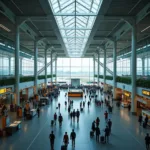Airports have undergone a dramatic transformation in the last 20 years. From enhanced security measures to technological advancements and a focus on passenger experience, the evolution of airports is remarkable. This article explores 20 significant changes that have reshaped the airport landscape, impacting how we travel and experience these global hubs.
From Check-in Chaos to Seamless Self-Service
Remember the days of long queues at check-in counters? Now, self-service kiosks and online check-in options allow travelers to bypass traditional lines and manage their itineraries with ease. This shift has not only saved time but also empowered passengers to control their travel experience from the comfort of their homes or upon arrival at the airport. Mobile boarding passes further streamline the process, reducing paper waste and providing convenient access to flight information.
Enhanced Security: A New Era of Travel
Post 9/11, airport security measures have intensified significantly. The introduction of full-body scanners, enhanced baggage screening, and stricter regulations have become the new norm. While these changes have undoubtedly increased travel time, they’ve also prioritized passenger safety and fostered a more secure environment. Pre-check programs like TSA PreCheck and Global Entry offer expedited screening for eligible travelers, balancing security with efficiency.
The Rise of Biometrics: A Futuristic Approach
Biometric technology is increasingly being integrated into airport processes, including check-in, security, and boarding. Facial recognition, fingerprint scanning, and iris scanning offer a seamless and secure way to verify passenger identities, further automating the travel journey and reducing reliance on traditional documents. This futuristic approach promises faster processing times and enhanced security.
The Airport as a Destination: Beyond Just a Transit Hub
Airports are no longer just transit points; they’ve evolved into destinations in their own right. Shopping malls, restaurants, spas, and entertainment facilities offer travelers a wide range of amenities to enjoy before or after their flights. This transformation reflects the increasing dwell time at airports and the demand for a more engaging and enjoyable travel experience.
 Airport Retail and Dining Evolution in 20 Years
Airport Retail and Dining Evolution in 20 Years
Connectivity is King: The Wi-Fi Revolution
Free and readily available Wi-Fi has become a standard expectation at airports worldwide. This connectivity revolution has enabled travelers to stay connected with work, family, and friends, access travel information, and entertain themselves during layovers. Improved internet speeds and reliable connections have enhanced the overall airport experience.
Navigating the Maze: Improved Wayfinding
Modern airports employ sophisticated wayfinding systems to guide travelers through complex terminals. Digital displays, interactive maps, and clear signage help passengers navigate efficiently, reducing stress and improving the overall flow of traffic. Multilingual support caters to a diverse international clientele.
Sustainability Takes Flight: Eco-Friendly Initiatives
Airports are increasingly adopting sustainable practices to reduce their environmental impact. From energy-efficient lighting and water conservation measures to waste management programs and carbon offsetting initiatives, airports are prioritizing environmental responsibility. This shift reflects a growing global awareness of climate change and the need for sustainable travel solutions.
 Sustainable Initiatives at Airports
Sustainable Initiatives at Airports
The Rise of the Low-Cost Carrier: Changing the Aviation Landscape
The proliferation of low-cost carriers has drastically altered the aviation landscape, making air travel more accessible and affordable for a wider audience. This has led to increased passenger traffic and the development of secondary airports to accommodate the growing demand.
Personalized Travel Experiences: Catering to Individual Needs
Airports are increasingly utilizing data and technology to personalize the travel experience. From customized recommendations for dining and shopping to personalized flight information and assistance, airports are tailoring their services to meet the individual needs of travelers. This personalized approach enhances passenger satisfaction and fosters a more seamless and enjoyable travel journey.
Automation and Robotics: The Future of Airport Operations
Automated processes and robotics are playing an increasingly prominent role in airport operations, from baggage handling and security screening to customer service and cleaning. These technological advancements improve efficiency, reduce costs, and enhance the overall passenger experience.
 Airport Automation and Robotics
Airport Automation and Robotics
Improved Accessibility: Catering to All Travelers
Airports are prioritizing accessibility, making it easier for travelers with disabilities to navigate the airport environment. Ramps, elevators, accessible restrooms, and dedicated assistance services ensure that all travelers can enjoy a comfortable and stress-free journey.
Focus on Passenger Well-being: Creating a Relaxing Environment
Airports are recognizing the importance of passenger well-being and are incorporating features to create a more relaxing and comfortable environment. Quiet zones, wellness centers, and family-friendly amenities provide travelers with spaces to unwind and de-stress before or after their flights.
A New Era of In-Flight Entertainment: Staying Connected in the Air
In-flight entertainment systems have evolved dramatically, offering passengers a wide range of entertainment options, from movies and TV shows to music and games. Wi-Fi connectivity allows passengers to stay connected throughout their flight, further enhancing the in-flight experience.
The Evolution of Airport Lounges: A Premium Travel Experience
Airport lounges have become increasingly sophisticated, offering premium amenities and services to enhance the travel experience for frequent flyers and business travelers. Comfortable seating, complimentary food and beverages, and dedicated workspaces provide a haven for travelers seeking a more exclusive and productive environment.
24/7 Operations: Meeting the Demands of Global Travel
Many airports now operate 24/7 to accommodate the increasing demands of global travel. This allows for greater flexibility in flight schedules and provides travelers with more options for their journeys.
Increased Collaboration: Partnerships and Data Sharing
Airports are increasingly collaborating with airlines, government agencies, and other stakeholders to improve efficiency and enhance the passenger experience. Data sharing and integrated systems facilitate smoother operations and create a more seamless travel journey.
Enhanced Ground Transportation: Seamless Connections
Improved ground transportation options, including public transportation, rental cars, and ride-sharing services, offer travelers seamless connections to and from the airport. This enhanced connectivity streamlines the overall travel experience and reduces reliance on private vehicles.
The Rise of Mobile Technology: Managing Travel on the Go
Mobile technology has revolutionized the way we travel, empowering passengers to manage their itineraries, access flight information, and navigate the airport environment with ease. Mobile boarding passes, airport maps, and real-time flight updates provide travelers with convenient access to essential travel information at their fingertips.
A Focus on Customer Service: Enhancing the Passenger Experience
Airports are placing a greater emphasis on customer service, providing travelers with personalized assistance and support throughout their journey. Dedicated customer service representatives, multilingual staff, and online resources ensure that passengers receive the help they need, creating a more positive and enjoyable travel experience.
Conclusion: The Future of Air Travel
The past 20 years have witnessed remarkable changes in the airport landscape. From enhanced security measures and technological advancements to a focus on passenger experience and sustainability, these transformations have reshaped how we travel. As technology continues to evolve and passenger expectations continue to rise, airports will undoubtedly continue to adapt and innovate, creating a more seamless, efficient, and enjoyable travel experience for all. The future of air travel is bright, and airports will continue to play a crucial role in connecting people and cultures around the world.
FAQ
-
How has airport security changed in the last 20 years?
Airport security has significantly increased, with the introduction of full-body scanners, enhanced baggage screening, and stricter regulations. -
What role does technology play in modern airports?
Technology plays a crucial role, from self-check-in kiosks and biometric systems to digital wayfinding and personalized travel experiences. -
How are airports becoming more sustainable?
Airports are implementing eco-friendly initiatives, such as energy-efficient lighting, water conservation measures, and waste management programs. -
What are some of the amenities offered at modern airports?
Modern airports offer a wide range of amenities, including shopping malls, restaurants, spas, and entertainment facilities. -
How has the rise of low-cost carriers impacted airports?
The rise of low-cost carriers has led to increased passenger traffic and the development of secondary airports. -
How can I find my way around a large, unfamiliar airport?
Most modern airports have clear signage, interactive maps, and even digital displays to help you find your way. -
What can I do if I have a long layover at an airport?
Many airports now have amenities such as lounges, shopping areas, restaurants, and even spas to make your layover more comfortable.
Need further assistance? Contact us at Phone: +13089626264, Email: [email protected] or visit us at 404 Bothwell St, Oxford, NE 68967, USA. Our customer service team is available 24/7.

